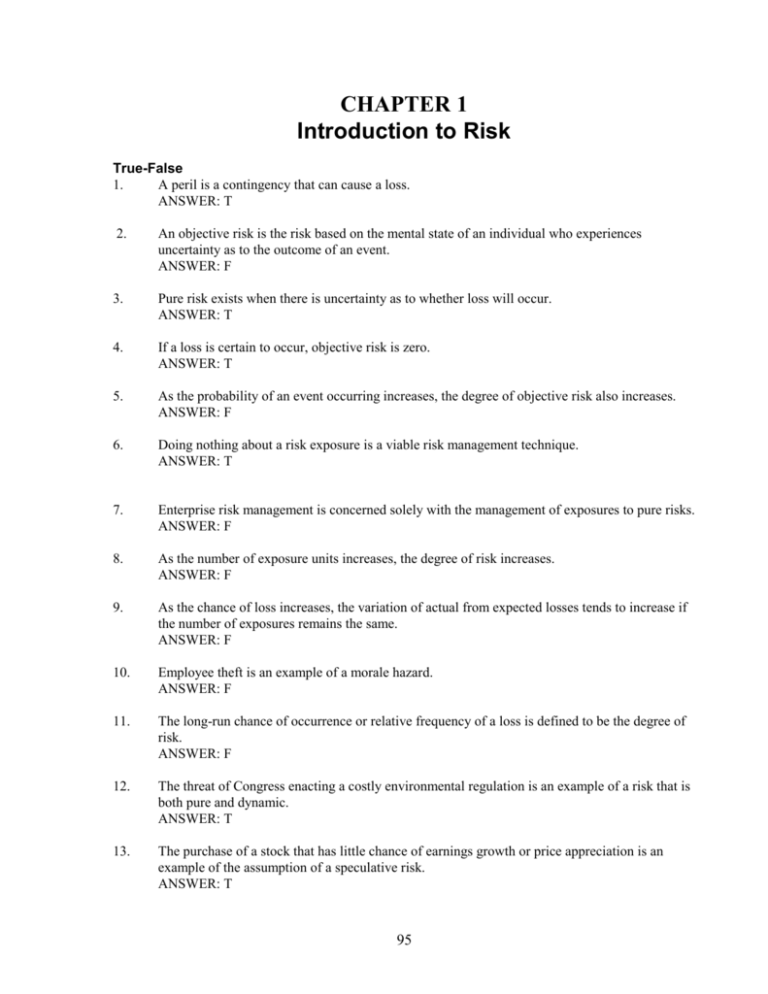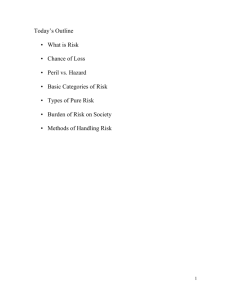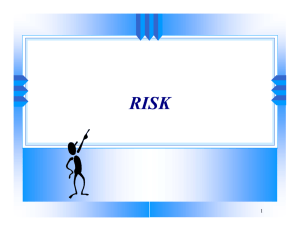FREE Sample Here
advertisement

CHAPTER 1 Introduction to Risk True-False 1. A peril is a contingency that can cause a loss. ANSWER: T 2. An objective risk is the risk based on the mental state of an individual who experiences uncertainty as to the outcome of an event. ANSWER: F 3. Pure risk exists when there is uncertainty as to whether loss will occur. ANSWER: T 4. If a loss is certain to occur, objective risk is zero. ANSWER: T 5. As the probability of an event occurring increases, the degree of objective risk also increases. ANSWER: F 6. Doing nothing about a risk exposure is a viable risk management technique. ANSWER: T 7. Enterprise risk management is concerned solely with the management of exposures to pure risks. ANSWER: F 8. As the number of exposure units increases, the degree of risk increases. ANSWER: F 9. As the chance of loss increases, the variation of actual from expected losses tends to increase if the number of exposures remains the same. ANSWER: F 10. Employee theft is an example of a morale hazard. ANSWER: F 11. The long-run chance of occurrence or relative frequency of a loss is defined to be the degree of risk. ANSWER: F 12. The threat of Congress enacting a costly environmental regulation is an example of a risk that is both pure and dynamic. ANSWER: T 13. The purchase of a stock that has little chance of earnings growth or price appreciation is an example of the assumption of a speculative risk. ANSWER: T 95 full file at http://testbankeasy.com 14. The degree of subjective risk is easily measured. ANSWER: F 15. The term objective risk is most often used in connection with pure static risks. ANSWER: T 16. If two companies have the same number of exposure units and experience the same average number of losses, then the degree of risk for each company tends to be equal. ANSWER: F 17. The degree of risk is essentially the same concept as the chance of loss. ANSWER: F 18. Fire is an example of a physical hazard. ANSWER: F Matching a. Dynamic risks 1. _________________ is the process of systematically managing risks through the following steps: identifying risks, evaluating risks, selecting risk management techniques, and implementing and reviewing decisions. b. Financial risk 2. A/An _________________ is a contingency that can cause a loss. c. Hazards 3. _________________ is uncertainty regarding loss. d. Integrated risk management 4. Probable variation of actual from expected losses divided by the expected loss is the _________________. e. moral hazard 5. _________________ does not include a chance of a gain and involves only uncertainty as to whether loss will occur. f. morale hazard 6. A/An _________________ is associated with intentional actions designed to either cause a loss or increase the severity of a loss. g. objective risk 7. _________________ involves uncertainty as to whether a gain or a loss will occur. h. peril 8. _________________ arises from psychological uncertainty that is based on an individual’s mental attitude or state of mind. i. Pure risk 9. _________________ are conditions that introduce or increase the probability of a loss stemming from the existence of a given peril. j. Risk 10. _________________ are caused by societal changes. k. Risk management 11. The mental attitude of a careless or accident prone person is referred to as _________________. full file at http://testbankeasy.com full file at http://testbankeasy.com l. Speculative risk 12. _________________ are those that would exist in an unchanging society that is in stable equilibrium. m. Static risk 13. A risk management approach in which an organization's speculative and pure risks are both considered together is known as either enterprise or _________________ risk management. n. Subjective risk 14. Credit risk, commodities, and interest rate risks are all examples of _________________. ANSWERS: 1. l 2 i 3 k 4 h 5 j 6 f 7 8 9 10 11 12 m o d a k g 13 14 15 16 n b e c Multiple Choice 1. Examples of physical hazards include a. a building fire b. a building fire, oily rags, and a dishonest employee c. oily rags and a gas leak d. a dishonest employee. ANSWER: C 2. Expressed as a percentage, what is the degree of objective risk if a company owns 1,000 cars, has averaged 25 collision losses per year, the collision losses will very likely range between 20 and 30, and last year’s loss experience was 23? a. 43.5 percent b. 92.0 percent c. 25.0 percent d. 40.0 percent. ANSWER: D 3. Which of the following are steps in the four-step risk management process described in the text? a. select risk management techniques and purchase insurance on selected risks b. select risk management techniques and identify risks c. select risk management techniques, purchase insurance on selected risks, and identify risks d. identify risks and analyze severity of expected losses. ANSWER: B full file at http://testbankeasy.com full file at http://testbankeasy.com 4. Risk is defined as a. uncertainty concerning loss b. the probable variation of actual from expected experience c. the long-run chance of occurrence or relative frequency of loss d. a specific contingency that may cause loss. ANSWER: A 5. In which of the following towns is the degree of objective risk from the peril of fire the highest? a. Town A has 10,000 homes with an average loss of 2 percent and a range of 100-250 losses per year b. Town B has 100,000 homes with an average loss of 5 percent and a range of 400-500 losses per year c. Town C has 1,000 homes with an average loss of 1 percent and a range of 7-15 losses per year d. Town D has 10,000 homes with an average loss of 3 percent and a range of 150-350 losses per year. ANSWER: C 6. Risk can be categorized as a. objective-subjective and perils-hazards b. objective-subjective, physical-moral-morale, and pure-speculative c. objective-subjective and pure-speculative d. objective-subjective, physical-moral-morale, pure-speculative, and perils-hazards. ANSWER: C 7. Pure risk may be said to create an economic burden in all except which of the following ways? a. reserve funds may be necessitated that may not yield the highest rate of return available, b. pure risk can result in feelings of mental unrest and worry that can drain human energies c. pure risk results in gambling, which is a destructive social force d. pure risk may deprive society of certain goods or services determined to bear excessive risk. ANSWER: C 8. Which of the following does not involve a moral hazard? a. a dishonest employee b. an employee known to falsify personal injury claims c. a driver who drives recklessly because he feels that any damage to his car will be covered by insurance d. a building owner who is considering torching the building. ANSWER: C 9. The formula used to calculate the degree of objective risk is a. probable variation of actual from expected losses divided by the expected loss b. expected loss multiplied by the quantity 1 minus variance divided by expected loss c. range of reasonable loss expectation divided by actual loss experience d. expected losses minus probable losses divided by the range of actual losses experienced. ANSWER: A full file at http://testbankeasy.com full file at http://testbankeasy.com 10. Which one of the following is not a risk management technique that a risk manager will typically choose for managing pure risks? a. purchase insurance to cover a risk exposure b. do nothing about a risk exposure c. sell a high risk investment to purchase one of lower risk d. establish a reserve fund. ANSWER: C 11. A peril that relates to a dynamic risk is a. an earthquake b. a riot c. death d. an increase in the consumption of cholesterol by society. ANSWER: B 12. An insurer is least likely to insure a. static risk b. pure risk c. objective risk d. speculative risk. ANSWER: D 13. Under which of the following conditions will objective risk decrease, assuming everything else remains constant? a. the number of exposure units increases b. the chance of loss decreases c. the number of exposure units decreases d. the probable variation of actual from objective losses increases. ANSWER: A 14. A peril that involves pure risk is a. a building fire that burns one of several company owned office buildings b. the purchase of a stock with a high degree of price fluctuation c. a competitor’s attempt to take market share from a business d. betting that the Dallas Cowboys will win the Super Bowl at the beginning of the football season. ANSWER: A 15. Which of the following represent hazards that affect the level of Company ABC’s liability risk? a. a large amount of debt in comparison with the level of ABC’s assets and an award of a judgment against ABC b. an award of judgment against ABC and the frequent occurrence of slippery spills on the floor of ABC’s personnel department c. the frequent occurrence of slippery spills on the floor of ABC’s personnel department and a particularly toxic waste product that is temporarily stored in a vacant lot next to a large chemical factory d. an award of judgment against ABC and a particularly toxic waste product that is temporarily stored in a vacant lot next to a large chemical factory. ANSWER: C full file at http://testbankeasy.com






